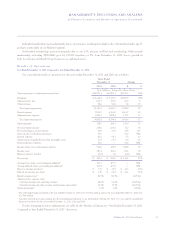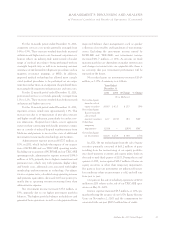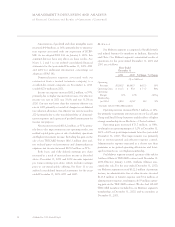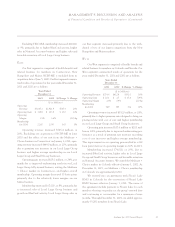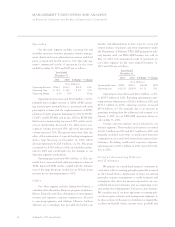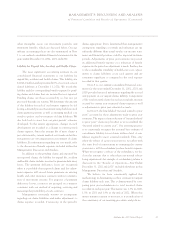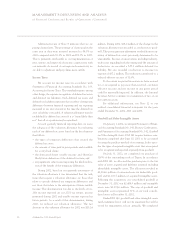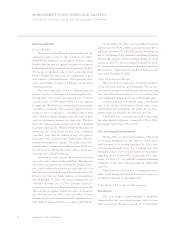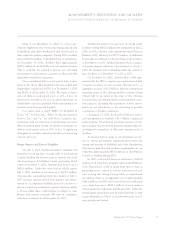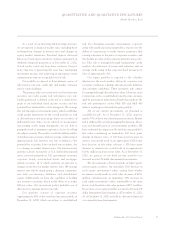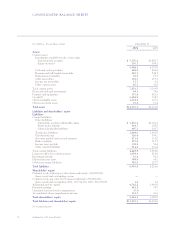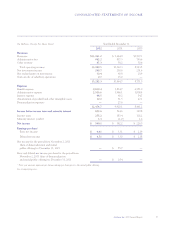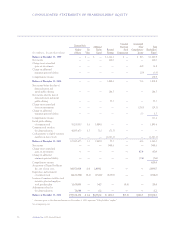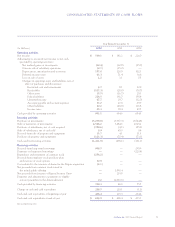Anthem Blue Cross 2002 Annual Report Download - page 54
Download and view the complete annual report
Please find page 54 of the 2002 Anthem Blue Cross annual report below. You can navigate through the pages in the report by either clicking on the pages listed below, or by using the keyword search tool below to find specific information within the annual report.
MANAGEMENT’S DISCUSSION AND ANALYSIS
of Financial Condition and Results of Operations (Continued)
Anthem, Inc. 2002 Annual Report 49
our transitional impairment test of existing goodwill
and other intangible assets (with indefinite lives) during
the second quarter of 2002. In addition, we completed
our annual impairment test of goodwill and other intangi-
ble assets (with indefinite lives) during the fourth quarter
of 2002. Based upon these tests we have not incurred any
impairment losses related to any intangible assets.
While we believe we have appropriately allocated the
purchase price of our acquisitions, this allocation requires
many assumptions to be made regarding the fair value of
assets and liabilities acquired. In addition, the annual
impairment testing required under FAS 142 requires us to
make assumptions and judgments regarding the estimated
fair value of our goodwill and intangibles. Such assump-
tions include the present value discount factor used to
determine the fair value of a reporting unit, which is ulti-
mately used to identify potential goodwill impairment.
Such estimated fair values might produce significantly dif-
ferent results if other reasonable assumptions and esti-
mates were to be used. Because of the amounts of goodwill
and other intangible assets included in our consolidated
balance sheet, the impairment analysis is significant. If we
are unable to support a fair value estimate in future annual
impairment tests, we may be required to record impair-
ment losses against future income.
For additional information, see Note 3 to our audited
consolidated financial statements for the years ended
December 31, 2002, 2001 and 2000.
Investments
Total investment securities were $5,948.1 million at
December 31, 2002 and represented 48% of our total con-
solidated assets at December 31, 2002. Our fixed maturity
and equity securities are classified as “available-for-sale”
securities and are reported at fair value. We have deter-
mined that all investments in our portfolio are available
to support current operations, and accordingly, have clas-
sified such securities as current assets. Investment income
is recorded when earned, and realized gains or losses,
determined by specific identification of investments sold,
are included in income when sold.
We evaluate our investment securities on a quarterly
basis, using both quantitative and qualitative factors, to
determine whether a decline in value is other than tem-
porary. Such factors considered include the length of time
and the extent to which a security’s market value has
been less than its cost, financial condition and near term
prospects of the issuer, recommendations of investment
advisors, and forecasts of economic, market or industry
trends. If any declines are determined to be other than
temporary, we charge the losses to income when that
determination is made. The current economic environ-
ment and recent volatility of securities markets increase
the difficulty of determining fair value and assessing
investment impairment. The same influences tend to
increase the risk of potentially impaired assets. Manage-
ment believes it has adequately reviewed for impairment
and that its investment securities are carried at fair value.
However, over time, the economic and market environ-
ment may provide additional insight regarding the fair
value of certain securities, which could change manage-
ment’s judgment regarding impairment. This could result
in realized losses relating to other than temporary
declines being charged against future income.
Through our investing activities, we are exposed to
financial market risks, including those resulting from
changes in interest rates and changes in equity market
valuations. Our primary objective is the preservation of
the asset base and maximization of portfolio income
given an acceptable level of risk. We manage the market
risks through our investment policy, which establishes
credit quality limits and percentage amount limits of
investments in individual issuers. If we are unable to
effectively manage these risks, it could have an impact on
our future earnings and financial position.
The unrealized losses of $7.8 million on our fixed
maturity securities at December 31, 2002 were substan-
tially related to interest rate changes. We expect the
scheduled principal and interest payments will be real-
ized. Our equity securities are comprised of indexed
mutual funds and the unrealized losses of $38.6 million at
December 31, 2002 were a result of the current market
fluctuations and are deemed to be temporary.
For additional information, see “Quantitative and
Qualitative Disclosures about Market Risk” and Note 4 to
our audited consolidated financial statements for the
years ended December 31, 2002, 2001 and 2000.




